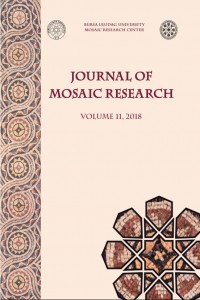Türkiye’de Mozaik Sanatın Çağdaşlaşması
Abstract
References
- Eyice 1980 S. Eyice, Son Devir Bizans Mimârisi, İstanbul‘da Palaisologos’lar Devri Anıtları (İstanbul).
- Fethi 1975 A. Fethi, “Duvara Çakılı Resim”, Unpublished Thesis for Proficiency in Arts, Mimar Sinan University Academy of Fine Arts, İstanbul.
- Vurnal 1993 H. Vurnal, “Roma Bizans Mozaik Sanatı Etkisi ile 1960 Sonrası Günümüze Kadar Mimaride Duvar Resmi Olarak Mozaik Sanatı ve Bedri Rahmi-Eren Eyüboğlu Mozaikleri”, Unpublished Master Thesis, Marmara University, Academy of Fine Arts, İstanbul.y of Fine Arts, İstanbul.
The Modernization of Mosaic Art in Turkey
Abstract
IIn Turkey, improvement of the mosaic art started in the Republic period with the help of far-sighted Atatürk who has attached great importance to history and art. The first excavation and restoration works started with foreign archaeologists. During that period, local archaeologists were also trained in order to keep these excavations up and running. Again in this period, Architect-Painter Association was founded after the“Fine Arts law”. The philosophy of the Bauhaus school, which aims to integrate the fine arts with architecture, has influenced our 1960 artists by the mosaics brought to light by our archaeologists. With the introduction of this law, between 1955 and 1970, Turkish artists applied the first original modern mosaic works to architecture. The “applied fine arts” (Today’s Marmara University Faculty of Fine Arts) was established under the influence of Bauhaus Art School. This school has trained artists who produced very successful works in architecture. In the 1960s Bedri Rahmi Eyüboğlu transferred the Plastic Art to architecture through the mosaic, as a pioneer. In 1990s H. Vurnal İkizgül pulled out mosaic art from architecture and carried it to today’s art.
Today, mosaic art is re-experiencing and renewing itself with several new techniques and materials. Therefore we must aim to acquire the innovative mosaic education institutions that will pioneer in the world. The emergent artistic production and accumulation by the new generation will raise us on the international platform and underpin of our Contemporary Mosaic Museum.
References
- Eyice 1980 S. Eyice, Son Devir Bizans Mimârisi, İstanbul‘da Palaisologos’lar Devri Anıtları (İstanbul).
- Fethi 1975 A. Fethi, “Duvara Çakılı Resim”, Unpublished Thesis for Proficiency in Arts, Mimar Sinan University Academy of Fine Arts, İstanbul.
- Vurnal 1993 H. Vurnal, “Roma Bizans Mozaik Sanatı Etkisi ile 1960 Sonrası Günümüze Kadar Mimaride Duvar Resmi Olarak Mozaik Sanatı ve Bedri Rahmi-Eren Eyüboğlu Mozaikleri”, Unpublished Master Thesis, Marmara University, Academy of Fine Arts, İstanbul.y of Fine Arts, İstanbul.
Details
| Primary Language | English |
|---|---|
| Subjects | Archaeology |
| Journal Section | Article |
| Authors | |
| Publication Date | November 30, 2018 |
| Published in Issue | Year 2018 Issue: 11 |

